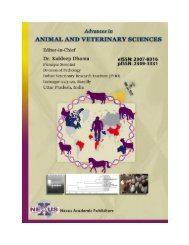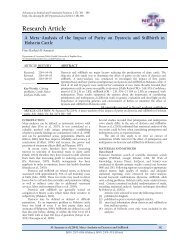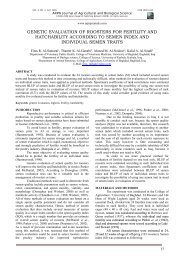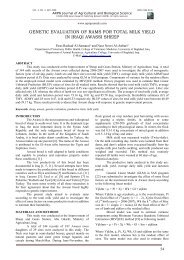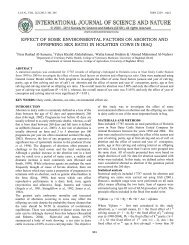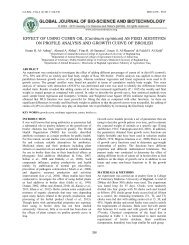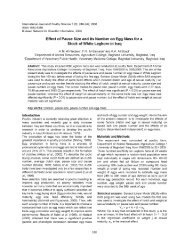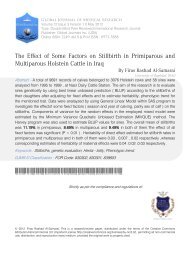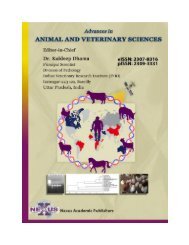o_1924omaf816ru1qj871317su170na.pdf
You also want an ePaper? Increase the reach of your titles
YUMPU automatically turns print PDFs into web optimized ePapers that Google loves.
I.J.A.B.R, VOL. 3(2) 2013: 227-230 ISSN 2250 3579<br />
ESTIMATION OF CORRELATED RESPONSE IN SOME LIFETIME<br />
TRAITS ACCORDING TO OTHER TRAITS IN HOLSTEIN COWS<br />
a Firas Rashad Al-Samarai, b Sadi Shalan Khalaf & c Falah Hamad Al-Zaidi<br />
a Department of Veterinary Public Health/ College of Veterinary Medicine / University of Baghdad/Iraq<br />
b Department of Animal Resources/ College of Agriculture/ University of Anbar/Iraq<br />
c Ministry of Agriculture/Directorate of Baghdad Agriculture/Department of Animal Resources/Iraq<br />
ABSTRACT<br />
Data belong to 944 Holstein cows, for the period from 1998 to 2004 in the Nasr dairy cattle station, United Company for<br />
Animal Resources Ltd., Al-Soueira ( 50 km south of Baghdad ), were analyzed. The aim of this study is to estimate the<br />
expected correlated response in some lifetime traits by using average milk yield per day of age at second calving<br />
(AVMSC) as an indicator trait for productive life (PL) and nunber of lactations (NL), whereas, the first milk yield (FMY)<br />
was used as an indicator trait for average milk yield per day of productive life (AVMPL), average milk yield per day of<br />
lifetime (AVML) and lifetime milk yield (LTMY). The results revealed that using selection intensity 1.64, 1.25 and 0.98 of<br />
cows according to the average milk yield per day of age at second calving caused expected increasing by 0.20, 0.15 and<br />
0.12 month/year in productive life and 0.022 , 0.017 and 0.013 lactation/year in number of lactations due to correlated<br />
response respectively. The corresponding estimates for the expected correlated response according to selection of sires on<br />
the first milk yield were 0.15 , 0.12 and 0.09 kg/year in the average milk yield per day of productive life , 0.10 , 0.07 and<br />
0.05 kg/year in the average milk yield per day of longevity and 278.58 , 212.33 and 166.47 kg/year in the lifetime milk<br />
yield respectively.<br />
KEY WORDS: correlated response, lifetime traits, indicator traits, Holstein cattle<br />
INTRODUCTION<br />
Milk yield and its components are the most important<br />
traits of selection for dairy cattle, and genetic progress for<br />
these traits has been well documented [1,2]. However, high<br />
milk yields may be associated with physiological changes<br />
that tend to limit further increases in productive economic<br />
herd life [3]. Dairy producers should be concerned to more<br />
maximizing the profitability of the cow with maximizing<br />
milk yield [4] , even if that approach implies suboptimal<br />
genetic progress for milk yield and component traits [5].<br />
Selection goals for dairy cattle should reflect profit over<br />
lifetime of cows [6, 7], but increased milk yield should be<br />
considered to be only part of the goal of maximizing profit<br />
[8].<br />
In the past, lifetime traits were excluded from most<br />
breeding program. Considering lifetime traits in a breeding<br />
program was generally thought to increase the generation<br />
interval compared with a program considering only<br />
production traits, because the information on lifetime traits<br />
only becomes available when cows were already culled<br />
[9]. However, as a consequence of the last two decades,<br />
more emphasis has been put on methods for genetic<br />
evaluation of lifetime traits [10]. One alternative is the use<br />
of satiability traits, the binomial traits that measure<br />
whether a cow has survived to a certain time (e.g. 48 mo<br />
of age, 300d in lactation) [11]. A second alternative is the<br />
use of survival analysis to obtain breeding values [12]. A<br />
third alternative is the use of correlated traits (e.g.<br />
conformation traits) [13]. Selection for one trait rarely<br />
affects just that one trait. Usually other traits are affected<br />
as well, genetic<br />
change in one or more traits resulting from selection for<br />
another is termed correlated response to selection, number<br />
of genetic mechanisms was probably caused correlated<br />
response, linkage is one, if major genes affecting two traits<br />
are closely linked, they will tend to stick together.<br />
Bourdon, [14] thought that linked genes do not remain<br />
together forever, because sooner or later recombination<br />
breaks the linkage and the major cause is pleiotropy.<br />
From a statistical perspective, genetic correlations between<br />
traits which measure the relative importance of pleiotropic<br />
effects on two traits caused correlated response to<br />
selection. Knowledge of relationships among traits is<br />
important for prediction of expected correlated response to<br />
selection [8].The present study was undertaken to estimate<br />
expected correlated response in some lifetime traits due to<br />
phenotypic selection of cows with different selection<br />
intensity according to indicator traits.<br />
MATERIALS & METHODS<br />
Data belong to 944 Holstein cows, for the period from<br />
1998 to 2004 in the Nasr dairy cattle station, United<br />
Company for Animal Resources Ltd., Al-Soueira ( 50 km<br />
south of Baghdad ), were analyzed to estimate the<br />
expected correlated response in some lifetime traits<br />
(productive life and nunber of lactations, average milk<br />
yield per day of productive life, average milk yield per day<br />
of longevity and lifetime milk yield) by phenotype<br />
selecting of cows according to two indicator traits<br />
(average milk yield per day of age at second calving and<br />
first milk yield). Due to first milk yield is very important<br />
economic trait which is usually use in evaluation the herd,<br />
while average milk yield per day of age at second calving<br />
might appear to be a useful criterion for comparing the<br />
economic merits of dairy animals because this measure<br />
227
Correlated response in some lifetime traits in Holstein cows<br />
combines three very important traits like age at first<br />
calving, first lactation yield and first calving interval [15].<br />
The trait was calculated by dividing the first lactation yield<br />
by the age at second calving reckoned as the total of the<br />
age at first calving and first calving interval. Forage were<br />
fed as part of the base ration. A more detailed description<br />
on feed intake and its measurement was given by Al-<br />
Anbari and Al-Samarai [16]<br />
Statistical analysis<br />
Statistical analysis included 944 records was carried out<br />
using SAS [17]. Expected correlated response in lifetime<br />
traits as a result of selection cows with different selection<br />
intensity according the indicator traits was estimated by<br />
using the following equation (Bourdon, 1997):<br />
BVy , x t = rBVx , BVy hx hy ix Py/ L<br />
Where BVy , x t = the rate of genetic change in trait Y<br />
per unit of time (t) due to phenotypic selection for trait X,<br />
rBVx , BVy = the genetic correlation between traits x and<br />
y,<br />
hx = the square root of heritability for trait x,<br />
hy = the square root of heritability for trait y,<br />
ix = selection intensity for trait x,<br />
Py = phenotypic variation for trait y,<br />
L = generation interval (5 years)<br />
Because there is a clear point of truncation, selection in<br />
this case is termed truncation selection, and a short method<br />
for calculating selection intensity is the number of cows<br />
chosen to be parents as a proportion of the number of<br />
potential parents or the proportion saved. The proportion<br />
selection intensity can then read from a certain table [14].<br />
We assumed that the selection included 123 cows out of<br />
944 cows which mean a proportion selection 13% and the<br />
corresponding selection intensity 1.64 and the selection of<br />
246 and 368 cows with a proportion selection 26, 39% and<br />
selection intensity 1.25 and 0.98 respectively. To<br />
determine whether selecting for an indicator trait is more<br />
effective than selecting directly for a trait of interest, we<br />
estimated response from both types of selection and<br />
expressed the results as a ratio by using the following<br />
equation [14]:<br />
BVy , x / BVy = r BVx , BVy hx ix / hy iy<br />
All notations in the equation are the same to notations of<br />
equation 1 except iy which denote to selection intensity<br />
in trait y.<br />
All genetic and phenotypic parameters were taken from<br />
[16, 18].<br />
two researches for the same data<br />
Several notions are using in this research and the meaning<br />
of each of them as following:<br />
AVMSC = average milk yield per day of age at second<br />
calving, PL = productive life NL = number of lactations,<br />
FMY = first lactation milk yield, AVMPL = average milk<br />
yield per day of productive life, AVML = average milk<br />
yield per day of lifetime milk yield, LTMY = lifetime milk<br />
yield, PL = productive life, NL = number of lactations.<br />
RESULTS & DISCUSSION<br />
Tables 1 and 2 show the genetic parameters used in this<br />
research, whereas table 3 show the expected correlated<br />
response in productive life at different intensities of<br />
selection 1.64, 1.25 and 0.98 which represent 123, 246<br />
and 368 cows out of 944 cows respectively, due to<br />
selection according to average milk yield per day of age at<br />
second calving at the the different selection intensities<br />
mentioned above, the expectation of correlated response in<br />
PL are 0.20, 0.15 and 0.12 month/year respectively. The<br />
corresponding estimates for number of lactations are<br />
0.022, 0.017 and 0.013 lactation/year.<br />
Concerning other life time traits, table 4 show the<br />
expected correlated response at selection intensity 1.64,<br />
1.25 and 0.98 of cows were 0.15, 0.12 and 0.10 (kg/year)<br />
for average milk yield per day of productive life, 0.09,<br />
0.07 and 0.05 (kg/year) for average milk yield per day of<br />
lifetime and 278.58, 212.33 and 166.47 (kg/year) for<br />
lifetime milk yield respectively. One way to determine<br />
whether selecting for an indicator trait is more effective<br />
than selection directly for a trait of interest is to estimate<br />
response from both types of selection and express the<br />
result as a ratio [14]. Its obvious from table 5 that most<br />
traits were dominated in response by selection for an<br />
indicator trait compared with directly selection. In view of<br />
the present results we support using an indicator trait<br />
because it will reduce the generation interval and increase<br />
the annual gain and profitability of dairy project. Similar<br />
conclusions were reported by Pryce et al., [19] who pointed<br />
to the importance of using indicator traits in selection<br />
indexes for improve function traits. It should be clear that<br />
the rate of genetic change in a population depends to a<br />
large degree on accuracy of selection or, more precisely,<br />
accuracy of breeding value prediction.<br />
Some traits had low estimate of heritability such as fitness<br />
traits (lifetime traits) and the information on these traits<br />
only becomes available when animals are already culled<br />
which means longer generation interval and low rate of<br />
genetic change, some else traits such as threshold traits<br />
which were defined as polygenetic traits that are not<br />
continuous in their expression, tend to have small selection<br />
intensity and then low rate of genetic change. One<br />
important alternative way to improve these traits is using<br />
indicator traits to selection for these traits particularly,<br />
when an indicator trait has a high heritability and can<br />
measured at early age.<br />
TABLE 1. Genetic parameters of average milk yield per day of age at second calving, productive life<br />
and number of lactations<br />
Trait<br />
AVMSC PL NL<br />
Trait<br />
AVMSC 0.39 0.43 0.47<br />
PL 0.02<br />
NL 0.02<br />
Estimates in diagonal represent the heritability (h²) of the traits<br />
Estimates upper diagonal represent genetic correlations (rG)<br />
228
I.J.A.B.R, VOL. 3(2) 2013: 227-230 ISSN 2250 3579<br />
TABLE 2. Genetic parameters of first milk yield and some lifetime traits<br />
Trait FMY AVMPL AVML LTMY<br />
Trait<br />
FMY 0.19 0.91 0.92 0.90<br />
AVMPL 0.20<br />
AVML 0.17<br />
LTMY 0.10<br />
Estimates in diagonal represent the heritability (h²) of the traits<br />
Estimates upper diagonal represent genetic correlations (rG)<br />
TABLE 3. Expected correlated response in PL and NL according to selection the cows for average milk yield per day of<br />
age at second calving at different selection intensities<br />
Trait<br />
Selection intensity<br />
1.64 1.25 0.98<br />
PL (kg/year) 0.20 0.15 0.12<br />
NL (lactation/year) 0.022 0.017 0.013<br />
Table 4. Expected correlated response in AVMPL, AVML and LTMY according to selection the cows for first lactation<br />
milk yield at different selection intensities<br />
Trait<br />
Selection intensity<br />
1.64 1.25 0.98<br />
AVMPL (kg/year) 0.15 0.12 0.10<br />
AVML (kg/year) 0.09 0.07 0.05<br />
LTMY (kg/year) 278.58 212.33 166.47<br />
TABLE 5. Selection for indicator traits and selection directly for traits expressed as ratio.<br />
Trait<br />
Ratio of response<br />
PL (months) 1.90<br />
NL (lactation) 2.08<br />
AVMPL (kg) 0.90<br />
AVML (kg)<br />
0.97<br />
LTMY (kg)<br />
1.23<br />
REFERENCES<br />
[1]. Van Vleck, L.D. (1985) Including records of<br />
daughters of selected bulls in estimation of sire<br />
components of variance. J.Dairy Sci., 68: 2396 <br />
2402.<br />
[2]. Van Tassell, C.P., and Van Vleck, L.D. (1991)<br />
Estimates of genetic selection defferentials and<br />
generation intervals for four paths of selections. J.<br />
Dairy Sci.,74: 1078 1083.<br />
[3]. Solkner, J. (1989) Genetic relationships between<br />
levels of production in different lactations, rate of<br />
maturity and longevity in a dual purpose cattle.<br />
Livest. Prod. Sci., 23: 33 38.<br />
[4]. Lin, C.Y., and Allaire, F.R. (1978) Efficiency of<br />
selection on milk yield to a fixed age. J. Dairy Sci.,<br />
61: 489 497.<br />
[5]. Pearson, R.B., and Miller, R.H. (1981) Economic<br />
definition of total performance, breeding goals, and<br />
breeding values for dairy cattle. J.Dairy Sci., 64: 857<br />
863.<br />
[6]. Burnside, E.B., McClintock, A.E., and Hammond, K.<br />
(1984) Type, production and longevity in dairy cattle:<br />
a review. Anim. Breed. Abstr.52: 171.<br />
[7]. Van Arendonk, J.A.M. (1989) Use of profit equations<br />
to determine relative economic value of dairy cattle<br />
herd life. J. Dairy Sci., 74: 1101 1109.<br />
[8]. Jairath, L. K., Hayes, J. F. and Cue, R.I. (1994)<br />
Multitrait restricted maximum likelihood estimates of<br />
genetic traits for Canadian Holsteins. J. Dairy Sci., 77<br />
: 303-312.<br />
[9]. Vollema, A. R. and Groen, A. F. (1998) A<br />
comparison of breeding value predictors for<br />
longevity using linear model and survival analysis. J.<br />
Dairy Sci., 81: 3315-3320.<br />
[10]. Vukasinovic, N. (1999) Application of survival<br />
analysis in breeding longevity. Interbull Bulletin, 21:<br />
3-10.<br />
[11]. Hudson, G. F. and Van Vleck, L.D. (1981)<br />
Relationship between production and stayability in<br />
Holstein cattle. J. Dairy Sci., 64 : 2246-2250.<br />
[12]. Ducrocq, V. (1994) Statistical analysis of length of<br />
productive life for dairy cows of the Normande<br />
breed. J. Dairy Sci., 77: 855-866.<br />
[13]. Brotherstone, S., Veerkamp, R.F. and Hill, W.G.<br />
(1998) Predicting breeding values for herd life of<br />
Holstein Friesian dairy cattle from lifespan and<br />
type. Anim. Sci., 67: 405-411.<br />
[14]. Bourdon, R. M. (1997) Understanding Animal<br />
Breeding. Prentice Hall, Upper Saddle River, NJ.<br />
07458.<br />
229
Correlated response in some lifetime traits in Holstein cows<br />
[15]. Deshpande, K.S., and Bonde, H.S. (1983) Genetic<br />
aspects of milk yield per day of age at second calving<br />
in Friesian x Sahiwal cross breed. Indian J.<br />
Anim.Sci., 82: 362 367.<br />
[16]. Al-Anbari, N.N., and Al-Samarai, F.R. (2007)<br />
Average milk yield per day of age at second calving<br />
as an indicator of productive life in Holstein. Iraqi<br />
Journal of Agriculture Sciences. 38: 87 93. (In<br />
Arabic).<br />
[17]. SAS.2001.SAS/STAT Users Guide for Personal<br />
Computer. Release 6.12.SAS Institute, Inc., Cary,<br />
N.C., USA.<br />
[18]. Al-Samarai, F.R. (2007) Genetic and phenotypic<br />
correlations between first milk yield and some<br />
lifetime traits in Holstein cows. Journal of Tikrit<br />
University for Agricultural Sciences.7: 41 50. (In<br />
Arabic).<br />
[19]. Pryce, J. E., Veerkamp, R. F. and Simm, G. (2000)<br />
Expected correlated response in health and fertility<br />
traits to selection on production in dairy cattle. 6 th<br />
World Congress on Genetics Applied to Livestock<br />
Production. Jan, 12-16, Armidale N.S.W., Australia.<br />
230



